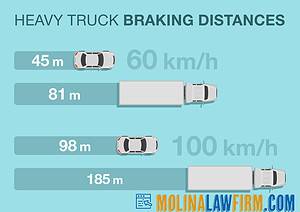
The open road is a symphony of moving parts, with vehicles of all sizes weaving a complex dance of logistics and travel. Among these, trucks are the behemoths—vital to our economy, yet representing a significant challenge to safety due to their size and weight. The Federal Motor Carrier Safety Administration (FMCSA) reports that 4,998 large trucks and buses were involved in fatal crashes in 2020, highlighting the critical need for safety awareness. This comprehensive guide offers on how to share the road safely with these giants and avoid truck accidents.
How to Avoid Truck Accidents: Understanding the Risks
The Reality of Truck Accidents on the Road
Every time you drive alongside a truck, you’re navigating a potential risk. Trucks have limited maneuverability and visibility, and when accidents occur, the consequences can be severe due to their massive size. Consider these sobering statistics from the FMCSA: large trucks are disproportionately involved in fatal accidents, with issues such as driver fatigue, speeding, mechanical failure, and adverse weather conditions often cited as contributing factors. Recognizing these risks is the first step toward prevention.
Common Causes of Truck Accidents
To understand how to avoid truck accidents, we must first understand what causes them. Here are some of the most common causes:
- Driver Fatigue: Long hauls and tight schedules can lead to drivers operating while tired, reducing reaction times and decision-making abilities.
- Speeding: The pressure to meet delivery deadlines can tempt truck drivers to exceed speed limits, making it harder to stop in emergencies.
- Distracted Driving: Like any driver, truck operators can become distracted by mobile devices, eating, or other activities that take their attention off the road.
- Mechanical Failures: Trucks require regular maintenance. When this is neglected, the risk of tire blowouts, brake failures, and other mechanical issues increases.
- Weather Conditions: Trucks are particularly vulnerable to adverse weather conditions due to their size and weight, which can affect stability and stopping distances.
By understanding these causes and learning how to avoid truck accidents, we can better prepare ourselves to anticipate and avoid potential dangers.
Preparing for the Drive
Pre-Trip Inspections and Precautions
A well-maintained vehicle is your first line of defense against accidents. Conducting a pre-trip inspection is not just a safety measure—it’s a proactive step towards ensuring your journey doesn’t end in tragedy. Here’s a detailed checklist to follow:
- Brakes: Test your brakes for responsiveness. Listen for any unusual noises that could indicate wear or damage.
- Lights: Check all lights, including headlights, brake lights, and turn signals, to ensure they’re fully operational.
- Tires: Inspect your tires for proper inflation and adequate tread depth. Remember, your tires are the only contact between your vehicle and the road.
- Mirrors: Adjust all mirrors to minimize blind spots. This is especially important when you’ll be driving near large trucks.
Taking these steps can significantly reduce the risk of accidents caused by vehicle malfunctions.
Safety Tips While Driving
Defensive Driving Techniques Around Trucks
Defensive driving is about anticipation, respect for other road users, and understanding the limitations of large vehicles like trucks. The Federal Motor Carrier Safety Administration has some safety tips for truck drivers. Here are some defensive driving techniques to keep in mind:
- Keep a Safe Distance: Always maintain a safe following distance from trucks. A good rule of thumb is to allow at least one second for every 10 feet of vehicle length at speeds under 40 mph. For higher speeds, add an additional second.
- Be Aware of Blind Spots: Trucks have large blind spots on all sides. Avoid lingering in these “No Zones” where the truck driver may not see you.
Overtaking and Passing Trucks Safely
Overtaking a truck is not the same as passing a car. Their size and the physics involved demand extra caution. 14 feet is the maximum height of a large truck in Texas. Here’s how to do it safely:
- Pass on the Left: The truck’s left side has smaller blind spots, making it safer for passing.

- Do Not Linger: Pass with purpose and do not stay alongside the truck for longer than necessary.
Navigating Intersections and Turns
Intersections and turns are hotspots for accidents with trucks. Understanding a truck’s movements can help you anticipate their actions:
- Anticipate Wide Turns: Trucks often need to swing wide to navigate turns. Give them plenty of space and never try to squeeze by on the inside of a turning truck.
- Never Squeeze In: Cutting in too close in front of a truck at an intersection can be dangerous. Trucks cannot stop as quickly as cars, so ensure there is ample space before changing lanes or merging.
Environmental and Road Conditions
Adapting to Weather and Traffic
Weather and traffic conditions can change the driving game entirely, especially when large trucks are involved. Here’s how to adapt:
- Reduce Speed: In rain, snow, or fog, reduce your speed. Wet and icy roads can double or even triple the normal stopping distance.
- Increase Following Distance: In heavy traffic or poor weather, increase your following distance even more. This gives you more time to react if a truck ahead of you stops suddenly or encounters problems.
Avoiding Distractions
Staying Focused Behind the Wheel
Distractions are a leading cause of accidents. In the time it takes to glance at a text message, a vehicle can travel the length of a football field—blindly. Here’s how to minimize distractions:
- Eliminate Phone Use: Turn off notifications or use a “do not disturb while driving” feature on your smartphone.
- Secure Loose Items: Make sure all items in your car are stowed securely. Loose objects can become dangerous projectiles in a sudden stop or crash.
Responding to Emergencies
What to Do in a Close Call
Even with the best preparation, emergencies can happen. Knowing how to respond can make all the difference:
- Stay Calm: Keeping a clear head allows you to make rational decisions quickly.
- Practice Emergency Maneuvers: Be familiar with maneuvers like controlled braking and steering around obstacles.
Legal Considerations and Insurance
Knowing Your Rights and Responsibilities
If you’re involved in an accident with a truck, it’s essential to know what to do:
- Report Immediately: Always report the accident to the authorities as soon as possible.
- Understand Your Coverage: Familiarize yourself with your insurance policy’s details regarding accidents with large vehicles.
Call the Houston Truck Accident Lawyers at Molina Law Firm today for Help
Sharing the road with trucks doesn’t have to be a daunting prospect. By following these safety tips and maintaining a vigilant and proactive approach to driving, you can significantly reduce the risk of accidents. Remember, safety on the road is a shared responsibility. By doing your part and learning how to avoid truck accidents, you contribute to a safer driving environment for everyone.
We hope this guide empowers you to drive with confidence and caution. Share this article with friends and family to spread the word about road safety. Together, we can make a difference.
For more information, contact the Houston personal injury law firm of Attorney Rick Molina by calling (713) 529-4357. A truck accident attorney is available now.


